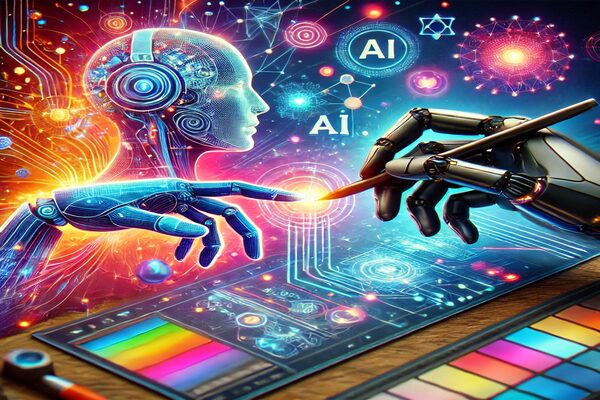In the ever-evolving world of technology, the intersection of machine learning and graphic design has become a focal point for innovation. Designers are increasingly leveraging machine learning to enhance their creative processes, making it essential for digital creators to understand how this technology can be integrated into their work. Whether you’re a seasoned designer or just starting, the influence of machine learning in graphic design is a topic worth exploring.
As we delve into the world of machine learning in graphic design, it’s important to understand its impact on the industry. This technology not only streamlines workflows but also opens up new creative possibilities. From automating repetitive tasks to generating novel design ideas, machine learning is revolutionizing how designers approach their craft.

Understanding Machine Learning
Before diving into its applications in graphic design, let’s first understand what machine learning is. At its core, machine learning is a subset of artificial intelligence (AI) that enables computers to learn from data and improve their performance over time without being explicitly programmed. This ability to learn and adapt makes machine learning a powerful tool in various fields, including graphic design.
How Machine Learning Works
Machine learning algorithms are designed to identify patterns in data and make predictions based on those patterns. By processing large amounts of data, these algorithms can recognize trends and generate insights that would be difficult for humans to identify on their own. This process is akin to teaching a computer to think and learn like a human, allowing it to perform tasks such as image recognition, language processing, and even creative design.
The Role of Machine Learning in Graphic Design
The integration of machine learning in graphic design has transformed the industry in numerous ways. Here are some key areas where this technology is making a significant impact:
Automating Repetitive Tasks
One of the most practical applications of machine learning in graphic design is the automation of repetitive tasks. Designers often spend a considerable amount of time on mundane tasks such as resizing images, adjusting colors, and organizing layouts. With machine learning, these tasks can be automated, freeing up designers to focus on more creative aspects of their work.
Enhancing Creativity
Machine learning is also playing a crucial role in enhancing creativity. By analyzing vast amounts of data, machine learning algorithms can generate unique design ideas and suggest new color palettes, layouts, and styles. This not only inspires designers but also pushes the boundaries of traditional design.
Personalized Design Experiences
Another exciting application of machine learning in graphic design is the creation of personalized design experiences. By analyzing user preferences and behaviors, machine learning algorithms can tailor designs to meet individual needs. This level of customization enhances user engagement and ensures that designs resonate with their intended audience.
Real-World Applications of Machine Learning in Graphic Design
Let’s explore some real-world examples of how machine learning is being used in graphic design:
Adobe Sensei
Adobe Sensei is a prime example of machine learning in action. This AI-powered platform is integrated into Adobe’s suite of creative tools, allowing designers to automate tasks, enhance images, and generate design suggestions. With Adobe Sensei, designers can streamline their workflows and achieve more in less time.
Canva’s Design Automation
Canva, a popular online design tool, utilizes machine learning to simplify the design process. The platform’s AI-powered features can generate layouts, recommend design elements, and even suggest improvements. This makes it easier for non-designers to create professional-quality designs.
DeepArt and Artistic Style Transfer
DeepArt is a fascinating application of machine learning that allows users to transform photos into works of art. By using a technique known as artistic style transfer, DeepArt can apply the style of famous paintings to images, creating unique and visually stunning results.
Challenges and Considerations
While the benefits of machine learning in graphic design are significant, there are also challenges to consider. It’s important for designers to understand the limitations of machine learning algorithms and ensure that their work remains ethical and authentic.
Maintaining Authenticity
As machine learning takes on a larger role in graphic design, designers must be cautious about maintaining authenticity. While algorithms can generate impressive designs, it’s crucial to ensure that the final output reflects the designer’s unique vision and style.
Addressing Bias
Another challenge is addressing bias in machine learning algorithms. Since these algorithms learn from data, they can inadvertently perpetuate existing biases. Designers must be vigilant in ensuring that their work is inclusive and free from bias.
Future Trends in Machine Learning and Graphic Design
Looking ahead, the future of machine learning in graphic design is promising. As technology continues to evolve, we can expect even more innovative applications and tools that will further enhance the design process.
AI-Driven Design Tools
AI-driven design tools are set to become more sophisticated, offering designers new ways to create and collaborate. These tools will enable designers to experiment with different styles and techniques, ultimately leading to more diverse and dynamic designs.
Integration with Augmented Reality
The integration of machine learning with augmented reality (AR) is another exciting trend. By combining these technologies, designers can create immersive experiences that blend the digital and physical worlds, opening up new possibilities for interactive design.
Conclusion
The influence of machine learning in graphic design is undeniable. As this technology continues to advance, it will shape the future of design in ways we can only imagine. By embracing machine learning, designers can unlock new levels of creativity and efficiency, ultimately transforming the way we create and experience design.
To learn more about how AI is impacting graphic design, check out this article. For those looking to dive deeper into design tools, explore the resources at DzinerStudio.

FAQ
How does machine learning benefit graphic designers?
Machine learning benefits graphic designers by automating repetitive tasks, enhancing creativity, and enabling personalized design experiences. This allows designers to focus on more creative aspects of their work.
Can machine learning replace graphic designers?
While machine learning can assist in the design process, it cannot replace the creativity and intuition of human designers. It serves as a tool to enhance their work rather than replace it.
What are some popular machine learning tools for graphic design?
Popular machine learning tools for graphic design include Adobe Sensei, Canva’s design automation features, and DeepArt for artistic style transfer. These tools help streamline workflows and inspire creativity.







